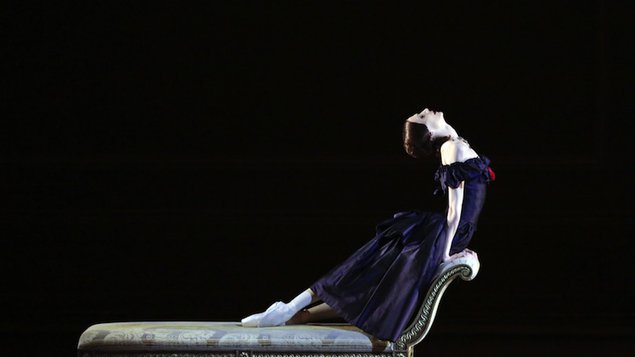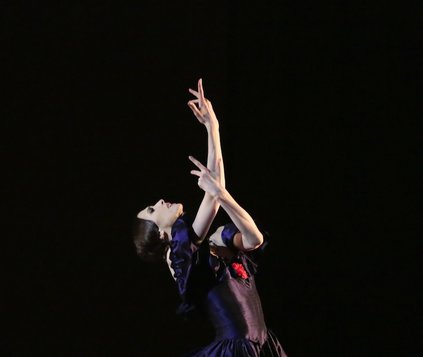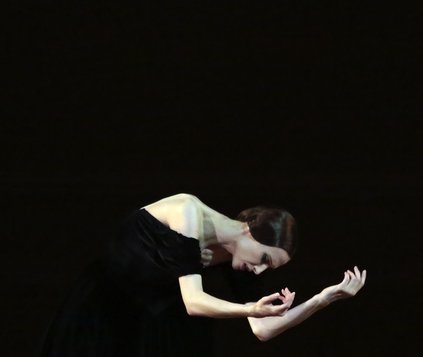Neumeier’s Lady of the Camellias – When dance speaks…
 There are not many artists able to create narrative ballets without making the spectator lost in the complexity of the storyline. One of the best choreographers-narrators, who will captivate you by his immense movement imagination and emotionality, is John Neumeier (1942). Since 1973, his name has been linked with the Hamburg Ballet, an ensemble which has become one of the most prestigious dance bodies under his direction. Neumeier’s choreographies also appear in the repertories of other renowned theatres – and so it was possible to watch the live relay of his Lady of the Camellias, premiered in 2014 in Moscow’s Bolshoi Theatre, whose ballet productions have been broadcast for several seasons within Ballet in Cinemas.
Those who decided to go to see the ballet in the Lucerna Cinema got the best of the contemporary ballet repertory. John Neumeier never allows staging of his ballets without careful casting process and rigorous rehearsals. Lady of the Camellias made its premiere many years ago (1978) but it does not seem to age - because in this piece, dance speaks so strongly… when body language is more than expressive, there is no need for words. The cinema experience is no less authentic than the live performance in the Bolshoi Theatre in Moscow. As Svetlana Zakharova said during her guesting in Prague in 2013, live relays are always preceded by thorough rehearsals and so the cameras can take the stage with a fine sense of focusing on details, dramatic moments as well as distant shots.
Immortal story
There are not many artists able to create narrative ballets without making the spectator lost in the complexity of the storyline. One of the best choreographers-narrators, who will captivate you by his immense movement imagination and emotionality, is John Neumeier (1942). Since 1973, his name has been linked with the Hamburg Ballet, an ensemble which has become one of the most prestigious dance bodies under his direction. Neumeier’s choreographies also appear in the repertories of other renowned theatres – and so it was possible to watch the live relay of his Lady of the Camellias, premiered in 2014 in Moscow’s Bolshoi Theatre, whose ballet productions have been broadcast for several seasons within Ballet in Cinemas.
Those who decided to go to see the ballet in the Lucerna Cinema got the best of the contemporary ballet repertory. John Neumeier never allows staging of his ballets without careful casting process and rigorous rehearsals. Lady of the Camellias made its premiere many years ago (1978) but it does not seem to age - because in this piece, dance speaks so strongly… when body language is more than expressive, there is no need for words. The cinema experience is no less authentic than the live performance in the Bolshoi Theatre in Moscow. As Svetlana Zakharova said during her guesting in Prague in 2013, live relays are always preceded by thorough rehearsals and so the cameras can take the stage with a fine sense of focusing on details, dramatic moments as well as distant shots.
Immortal story
 The Lady of the Camellias (1848, La Dame aux camélias), written by Alexandre Dumas fils, is an autobiographical, romantic novel depicting a great ill-fated love affair. The book became very successful and was adapted for the stage in 1852 by Dumas himself. It also inspired Giuseppe Verdi who composed the opera La Traviata a year later. The novel has been adapted for cinema many times - one of the best known cinema versions is Mauro Bolognini’s film from 1980, starring the French actress Isabelle Huppert.
The lead character of the novel, Marguerite Gautier, is based on Dumas’ real-life lover, courtesan Marie Duplessis. Few people knew about her devastating lung disease. The story is set in the early-19th-century Paris – it opens with Dumas’ description of the auction of Marguerite Gautier’s possessions. The narrator only knew the woman by sight; he was sure, however, that she let herself be seen in Parisian theatres, usually accompanied by one of her lovers. She always wore white camellias, just for five days in a month the flowers were red. Therefore she was called the Lady of the Camellias. At the auction, the author bought a copy of Manon Lescaut with an inscription by Armand Duval inside. Thanks to the novel, he befriends Armand, just returned from his travels and the new owner of the book. The author then gave Manon Lescaut back to Armand, the two men became friends and Armand told his story to Dumas.
Neumeier was inspired by Dumas‘s work, he changed some details, though. Armand Duval himself attends the same of his fatal lover’s effects and it triggers a kaleidoscope of memories, danced in three acts with an epilogue and prologue (the programme to the relay was rather unreadable, including the plot summary which contained misleading information about the ballet having only two acts). Marguerite meets Armand during a performance of the ballet Manon Lascaut, a piece about the tragic romance of the most famous rococo courtesan and a parallel to the lead characters’ destiny. Therefore, Marguerite and Armand see the theatre drama as a premonition and so the relationship of des Grieux and his mistress reflects the feelings of the central couple.
Armand is bewitched by Marguerite from the moment he is introduced to her at the theatre. Later he professes his love and she consents to take him as her lover. Armand is happy, even though Marguerite is still kept by Count N. But Marguerite eventually leaves her benefactor and settles with Armand in the country. One day, Armand must leave for Paris and when he comes back, his lover is gone. Her servant Nanine gives him a letter saying that Marguerite leaves him. Armand, completely broken, is persuaded to depart with his father, who pleaded Marguerite to stay away from his son.
Armand returns to Paris and encounters Marguerite at a ball, in the company of Count N.. Full of bitterness, Armand flirts with the young courtesan Olympia. Marguerite visits Armand because she knows that he his affair with Olympia is no more than an act of revenge. She begs him to stop hurting her and they spend a night together. However, the next day Armand finds out Marguerite stays with Count N. In the final scene, Marguerite is writing the last pages of her diary and she envisions the last moments of Manon. She dies alone, the last tones of Chopin’s Largo from Sonata in B minor are fading away. Armand silently closes the diary Nanina has given to him.
Dramaturgic coherence
The ballet owes its strength to, besides others, the adjustments that Neumeier has made to complete his vision. The dramaturgic coherence and blending of two fatal relationships pictured in the scenes of ‘ballet inside a ballet’, show how the piece is elaborated with deep emotionality (in the interview, Svetlana Zakharova remembers Neumeier crying during the rehearsal of one of the duets). The story consists of a series of scenes, each of them having inimitable allure and atmosphere.
The Lady of the Camellias (1848, La Dame aux camélias), written by Alexandre Dumas fils, is an autobiographical, romantic novel depicting a great ill-fated love affair. The book became very successful and was adapted for the stage in 1852 by Dumas himself. It also inspired Giuseppe Verdi who composed the opera La Traviata a year later. The novel has been adapted for cinema many times - one of the best known cinema versions is Mauro Bolognini’s film from 1980, starring the French actress Isabelle Huppert.
The lead character of the novel, Marguerite Gautier, is based on Dumas’ real-life lover, courtesan Marie Duplessis. Few people knew about her devastating lung disease. The story is set in the early-19th-century Paris – it opens with Dumas’ description of the auction of Marguerite Gautier’s possessions. The narrator only knew the woman by sight; he was sure, however, that she let herself be seen in Parisian theatres, usually accompanied by one of her lovers. She always wore white camellias, just for five days in a month the flowers were red. Therefore she was called the Lady of the Camellias. At the auction, the author bought a copy of Manon Lescaut with an inscription by Armand Duval inside. Thanks to the novel, he befriends Armand, just returned from his travels and the new owner of the book. The author then gave Manon Lescaut back to Armand, the two men became friends and Armand told his story to Dumas.
Neumeier was inspired by Dumas‘s work, he changed some details, though. Armand Duval himself attends the same of his fatal lover’s effects and it triggers a kaleidoscope of memories, danced in three acts with an epilogue and prologue (the programme to the relay was rather unreadable, including the plot summary which contained misleading information about the ballet having only two acts). Marguerite meets Armand during a performance of the ballet Manon Lascaut, a piece about the tragic romance of the most famous rococo courtesan and a parallel to the lead characters’ destiny. Therefore, Marguerite and Armand see the theatre drama as a premonition and so the relationship of des Grieux and his mistress reflects the feelings of the central couple.
Armand is bewitched by Marguerite from the moment he is introduced to her at the theatre. Later he professes his love and she consents to take him as her lover. Armand is happy, even though Marguerite is still kept by Count N. But Marguerite eventually leaves her benefactor and settles with Armand in the country. One day, Armand must leave for Paris and when he comes back, his lover is gone. Her servant Nanine gives him a letter saying that Marguerite leaves him. Armand, completely broken, is persuaded to depart with his father, who pleaded Marguerite to stay away from his son.
Armand returns to Paris and encounters Marguerite at a ball, in the company of Count N.. Full of bitterness, Armand flirts with the young courtesan Olympia. Marguerite visits Armand because she knows that he his affair with Olympia is no more than an act of revenge. She begs him to stop hurting her and they spend a night together. However, the next day Armand finds out Marguerite stays with Count N. In the final scene, Marguerite is writing the last pages of her diary and she envisions the last moments of Manon. She dies alone, the last tones of Chopin’s Largo from Sonata in B minor are fading away. Armand silently closes the diary Nanina has given to him.
Dramaturgic coherence
The ballet owes its strength to, besides others, the adjustments that Neumeier has made to complete his vision. The dramaturgic coherence and blending of two fatal relationships pictured in the scenes of ‘ballet inside a ballet’, show how the piece is elaborated with deep emotionality (in the interview, Svetlana Zakharova remembers Neumeier crying during the rehearsal of one of the duets). The story consists of a series of scenes, each of them having inimitable allure and atmosphere.
 Neumeier was long looking for the right music score, he did not want to use Verdi’s opera and finally he decided for Frederic Chopin’s piano pieces. He used two pianists – one playing right on stage, the other one in the orchestra pit. The scenes flow, all of them visually pure – the blank backdrop changing colours according to their mood and atmosphere, costumes designed in the biedermeier style, in bright timbres. All this makes the ballet extremely visually appealing. The dancers’ bodies sometimes seem like shadows, half-dreams and half-reality.
The ballet presents superb dancing. Neumeier cannot deny he is the apprentice of John Cranko. Both choreographers are masters of duets and great narrators. The dance in Lady of the Camellias looks like a stream of movements, there are no boundaries, just horizons. The corps de ballet, pas de trois and other solos, laden with fine ingredients, create the same dazing impression. Everything inside the piece makes sense and confirms that you are witnessing something special. Neumeier develops the classical ballet technique into neoclassical forms, his inventiveness is truly opulent and he might even appear to touch something divine… His movement lines are precise but constantly changing; the steps, gestures, pauses, variations can be read like texts filled with emotions, experience and veracity.
Svetlana Zakharova is a unique dancer. Incredibly talented prima ballerina, endowed with the sense of expression not only in the face but in the whole body. Even in the most difficult passages she acted so spontaneously and confidently that you believed everything she was experiencing, without pathos but with intense inner empathy – Zakharova herself admitted that Marguerite is not a dancing role but rather a “dancing being”. The role of Armand was portrayed by the guest artist, Sevastopol’s Edvin Revazov, principal soloist of the Hamburg Ballet. Every subtle gaze in his impeccable performance conveyed thoughtfulness, grievance, joy or despair. He proved his high technical quality and all his pas de deux with Zakharova were brilliantly executed. All the performers, soloists as well as the corps de ballet members, floated lightly across the stage, masterfully and charmingly. The Bolshoi Theatre’s production of Lady of the Camellias simply resembles a finely cut diamond giving unforgettable sparkle.
Written from the live relay held on 6 December 2016, the Lucerna Cinema.
Lady of the Camellias
Choreography, staging and lights: John Neumeier
Music (according to the Bolshoi Theatre website): Frederic Chopin (except from Largo, Sonata in В minor, op. 58; Piano Concerto No. 2 in F minor, op. 21; Valse No. 1 in A-llat major, op. 34; Ecossaises, op. 72; Valse No. 3 in F major, op. 34; Prelude No. 2 in A minor, No. 17 in A-flat major, No. 15 in D-flat major, from 24 Preludes, op. 28;Valse No. 3 in F major, op. 34; Prelude No. 2 in A minor, No. 24 in D minor, from 24 Preludes, op. 28; Ballade No. 1 in G minor, op. 23; Andante spianato in E-flat major, op. 22; Grande polonaise brillante in E-flat major, op. 22; Romance, from the Piano Concerto No. 1 in E minor, op. 11
Sets and costumes: Jurgen Rose
Conductor: Pavel Sorokin
Pianist on the stage: Alexei Melentyev
Pianist in the pit: Pyotr Chukhnov
Repetiteurs: Kevin Haigen, Radik Zaripov and Janusz Mazon
Neumeier was long looking for the right music score, he did not want to use Verdi’s opera and finally he decided for Frederic Chopin’s piano pieces. He used two pianists – one playing right on stage, the other one in the orchestra pit. The scenes flow, all of them visually pure – the blank backdrop changing colours according to their mood and atmosphere, costumes designed in the biedermeier style, in bright timbres. All this makes the ballet extremely visually appealing. The dancers’ bodies sometimes seem like shadows, half-dreams and half-reality.
The ballet presents superb dancing. Neumeier cannot deny he is the apprentice of John Cranko. Both choreographers are masters of duets and great narrators. The dance in Lady of the Camellias looks like a stream of movements, there are no boundaries, just horizons. The corps de ballet, pas de trois and other solos, laden with fine ingredients, create the same dazing impression. Everything inside the piece makes sense and confirms that you are witnessing something special. Neumeier develops the classical ballet technique into neoclassical forms, his inventiveness is truly opulent and he might even appear to touch something divine… His movement lines are precise but constantly changing; the steps, gestures, pauses, variations can be read like texts filled with emotions, experience and veracity.
Svetlana Zakharova is a unique dancer. Incredibly talented prima ballerina, endowed with the sense of expression not only in the face but in the whole body. Even in the most difficult passages she acted so spontaneously and confidently that you believed everything she was experiencing, without pathos but with intense inner empathy – Zakharova herself admitted that Marguerite is not a dancing role but rather a “dancing being”. The role of Armand was portrayed by the guest artist, Sevastopol’s Edvin Revazov, principal soloist of the Hamburg Ballet. Every subtle gaze in his impeccable performance conveyed thoughtfulness, grievance, joy or despair. He proved his high technical quality and all his pas de deux with Zakharova were brilliantly executed. All the performers, soloists as well as the corps de ballet members, floated lightly across the stage, masterfully and charmingly. The Bolshoi Theatre’s production of Lady of the Camellias simply resembles a finely cut diamond giving unforgettable sparkle.
Written from the live relay held on 6 December 2016, the Lucerna Cinema.
Lady of the Camellias
Choreography, staging and lights: John Neumeier
Music (according to the Bolshoi Theatre website): Frederic Chopin (except from Largo, Sonata in В minor, op. 58; Piano Concerto No. 2 in F minor, op. 21; Valse No. 1 in A-llat major, op. 34; Ecossaises, op. 72; Valse No. 3 in F major, op. 34; Prelude No. 2 in A minor, No. 17 in A-flat major, No. 15 in D-flat major, from 24 Preludes, op. 28;Valse No. 3 in F major, op. 34; Prelude No. 2 in A minor, No. 24 in D minor, from 24 Preludes, op. 28; Ballade No. 1 in G minor, op. 23; Andante spianato in E-flat major, op. 22; Grande polonaise brillante in E-flat major, op. 22; Romance, from the Piano Concerto No. 1 in E minor, op. 11
Sets and costumes: Jurgen Rose
Conductor: Pavel Sorokin
Pianist on the stage: Alexei Melentyev
Pianist in the pit: Pyotr Chukhnov
Repetiteurs: Kevin Haigen, Radik Zaripov and Janusz MazonTranslation: Tereza Cigánková


